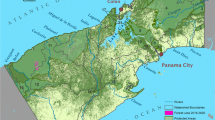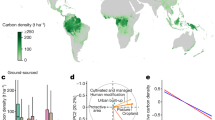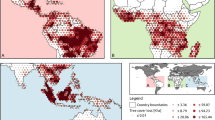Abstract
Afforestation of marginal agricultural lands represents a promising option for carbon sequestration in terrestrial ecosystems. An ecosystem carbon model was used to generate new national maps of annual net primary production (NPP), one each for continuous land covers of ‘forest’, ‘crop’, and ‘rangeland’ over the entire U. S. continental area. Direct inputs of satellite “greenness” data from the Advanced Very High Resolution Radiometer (AVHRR) sensor into the NASA-CASA carbon model at 8-km spatial resolution were used to estimate spatial variability in monthly NPP and potential biomass accumulation rates in a uniquely detailed manner. The model predictions of regrowth forest production lead to a conservative national projection of 0.3 Pg C as potential carbon stored each year on relatively low-production crop or rangeland areas. On a regional level, the top five states for total crop afforestation potential were: Texas, Minnesota, Iowa, Illinois, and Missouri, whereas the top five states for total rangeland afforestation potential are: Texas, California, Montana, New Mexico, and Colorado. Afforestation at this level of intensity has the capacity to offset at least one-fifth of annual fossil fuel emission of carbon in the United States. These projected afforestation carbon gains also match or exceed recent estimates of the annual sink for atmospheric CO2 in currently forested area of the country.
Similar content being viewed by others
References
Alig R, Adams D, Mccarl B, Callaway JM, Winnett S (1997) Assessing effects of mitigation strategies for global climate change with an inter-temporal model of the U.S. forest and agriculture sectors. Environ Resour Econ 9:259–274
Birdsey RA, Heath LS (1995) Productivity of America's forest and climatic change. In: Joyce LA (ed) U.S. Department of Agriculture Forest Service, Rocky Mountain Forest and Range Experiment Station, Fort Collins, CO, General Technical Report RM-GTR 271, pp 56–70
Brown S, Sathaye J, Cannell M, Kauppi P (1996) Management of forests for mitigation of greenhouse gas emissions. In: Watson RT, Zinyowera MC, Moss RH (eds) Climate change 1995: impacts, adaptations and mitigation of climate change: scientific-technical analyses. Contribution of Working Group II to the Second Assessment Report of the Intergovernmental Panel on Climate Change. Cambridge University Press, Cambridge and New York, Chapter 24
Dixon RK (1995) Agroforestry systems: sources or sinks of greenhouse gas? Agroforestry Syst 31:99–116
Energy Information Administration (EIA) U.S. Department of Energy (2004) The voluntary reporting of greenhouse gases program. Report #: DOE/EIA-0608, Washington, DC, 81 pp
Energy Information Administration (EIA) U.S. Department of Energy (2003a) Method for calculating carbon sequestration by trees in urban and suburban settings. United States Department of Energy Voluntary Reporting of Greenhouse Gases Program, Washington, DC, 15 pp
Energy Information Administration (EIA) U.S. Department of Energy (2003b) Emissions of greenhouse gases in the United States 2002. Office of Integrated Analysis and Forecasting, Report number DOE/EIA-0573, Washington, DC, 126 pp
Friedl MA, McIver DK, Hodges JCF, Zhang XY, Muchoney D, Strahler H, Woodcock CE, Gopal S, Schneider A, Cooper A, Baccini A, Gao F, Schaaf C (2002) Global land cover mapping from MODIS: algorithms and early results. Remote Sensing Environ 83:287–302
Graham PJ (2003) Potential for climate change mitigation through afforestation: an economic analysis of fossil fuel substitution and carbon sequestration benefits. Agroforestry Syst 59: 85–95
Houghton RA, Hackler JL, Lawrence KT (1999) The US carbon budget: contributions from land-use change. Science 285:574–578
Intergovenmental Panel on Climate Change (IPCC) (2000) In: Watson RT, Noble IR, Bolin B, Ravindranath NH, Verardo DJ, Dokken DJ (eds) IPCC special report on land use, land-use change and forestry. Cambridge University Press, Cambridge, UK/New York, 377 pp
Knyazikhin Y, Martonchik JV, Myneni RB, Diner DJ, Running SW (1998) Synergistic algorithm for estimating vegetation canopy leaf area index and fraction of absorbed photosynthetically active radiation from MODIS and MISR data. J Geophys Res 103:32257–32276
Lewandrowski J, Peters M, Jones C, House R, Sperow M, Eve M, Paustian K (2004) Economics of sequestering carbon in the U.S. agricultural sector, economic research service. U.S. Department of Agriculture, Technical Bulletin No. (TB1909), 69 pp
Loveland TR, Reed BC, Brown JF, Ohlen DO, Zhu Z, Yang L, Merchant JW (2000) Development of a global land cover characteristics database and IGBP DISCover from 1 km AVHRR data. Int J Remote Sensing 21:1303–1365
Marland G, Fruit K, Sedjo R (2001) Accounting for sequestered carbon: the question of permanence. Environ Sci Policy 4:259–268
Marland G, Schlamadinger B (1997) Forests for carbon sequestration or fossil fuel substitution? A sensitivity analysis. Biomass Bioenergy 13:389–397
Myneni RB, Dong J, Tucker CJ, Kaufmann RK, Kauppi PE, Liski J, Zhou L, Alexeye1 V, Hughes MK (2000) A large carbon sink in the woody biomass of northern forests. PNAS 98:14784–14789
Nilsson S, Schopfhauser W (1995) The carbon-sequestration potential of a global afforestation programme. Climatic Change 30:267–293
Pacala SW, Hurtt GC, Baker D, Peylin P, Houghton RA, Birdsey RA, Heath L, Sundquist ET, Stallard RF, Ciais P, Moorcroft P, Caspersen JP, Shevliakova E, Moore B, Kohlmaier G, Holland E, Gloor M, Harmon ME, Fan S-M, Sarmiento JL, Goodale CL, Schimel D, Field CB (2001) Consistent land- and atmosphere-based U.S. carbon sink estimates. Science 292:2316–1320
Parton WJ, Schimel DS, Cole CV, Ojima DS (1987) Analysis of factors controlling soil organic matter levels in Great Plains grasslands. Soil Sci Soc Am J 51:1173–1179
Pew Center on Global Climate Change (2004) Climate change activities in the United States. Arlington, VA, 56 pp
Plantinga AJ, Mauldin T, Miller DJ (1999) An econometric analysis of the costs of sequestering carbon in forests. Am J Agric Econ 81:812–824
Potter CS (1999) Terrestrial biomass and the effects of deforestation on the global carbon cycle. BioScience 49:769–778
Potter CS, Randerson JT, Field CB, Matson PA, Vitousek PM, Mooney HA, Klooster SA (1993) Terrestrial ecosystem production: a process model based on global satellite and surface data. Global Biogeochemical Cycles 7(4):811–841
Potter C, Klooster S, Myneni R, Genovese V, Tan P, Kumar V (2003) Continental scale comparisons of terrestrial carbon sinks estimated from satellite data and ecosystem modeling 1982–98. Global Planetary Change 39:201–213
Running SW, Nemani RR, Heinsch Faith A, Zhao M, Reeves M, Hashimoto H (2004) A continuous satellite-derived measure of global terrestrial primary production. BioScience 54:547–560
Ryan MG, Hubbard RM, Pongracic S, Raison RJ, McMurtrie RE (1996) Foliage, fine-root, woody-tissue and stand respiration in Pinus radiata in relation to nitrogen status. Tree Physiol 16:333–343
Turner DP, Koerper GJ, Harmon ME, Lee JJ (1995) Carbon sequestration by forests of the United States: current status and projections to the year 2040. Tellus 47B:232–239
Valentini R, Matteucci G, Dolman AJ, Schulze E-D, Rebmann C, Moors EJ, Granier A, Gross P, Jensen NO, Pilegaard K, Lindroth A, Grelle A, Bernhofer C, Grunwald T, Aubinet M, Ceulemans R, Kowalski AS, Vesala T, Rannik U, Berbigier P, Loustau D, Gudmundsson J, Thorgeirsson H, Ibrom A, Morgenstern K, Clement R, Moncrieff J, Montagnani L, Minerbi S, Jarvis PG 2000. Respiration as the main determinant of carbon balance in European forests. Nature 404:861–865
VEMAP Participants, (2000) The VEMAP Phase I database: an integrated input dataset for ecosystem and vegetation modeling for the conterminous United States. CDROM and World Wide Web (URL: http://www.cgd.ucar.edu/vemap/)
Author information
Authors and Affiliations
Corresponding author
Rights and permissions
About this article
Cite this article
Potter, C., Klooster, S., Hiatt, S. et al. Satellite-derived estimates of potential carbon sequestration through afforestation of agricultural lands in the United States. Climatic Change 80, 323–336 (2007). https://doi.org/10.1007/s10584-006-9109-3
Received:
Revised:
Accepted:
Published:
Issue Date:
DOI: https://doi.org/10.1007/s10584-006-9109-3




